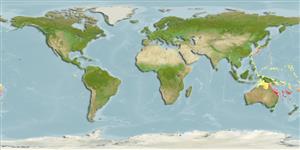Common names from other countries
Classification / Names / Names
Namen | Synonyme | Catalog of Fishes (gen., sp.) | ITIS | CoL | WoRMS
Environment: milieu / climate zone / depth range / distribution range
Ökologie
; tiefenbereich 1 - 54 m (Ref. 96968). Tropical
Pacific Ocean.
Length at first maturity / Size / Gewicht / Alter
Maturity: Lm ? range ? - ? cm Max length : 32.0 cm TL Männchen/unbestimmt; (Ref. 96968); max. veröff. Gewicht: 300.00 g (Ref. 96968)
Its mantle length is 10 cm (Ref. 96968). Depths range from 1 to 54 m. Occurs on sandy substrates, often associated with coral heads or rubble. Deep lairs are excavated under coral heads or coral rubble on sand substrate. Appears to have crepuscular activity patterns. Lairs are surrounded by cast off gastropod shells which may have been collected for their secondary occupants, hermit crabs. Stomach contents have a high proportion of crustacean exoskeletal fragments. Eggs are laid in large numbers in festoons. The small egg size indicates hatchlings are planktonic. Possibly venomous based on the prominent warning coloration and being locally known as the "poison octopus". Live animals observed to bite objects willingly, uncommon amongst octopuses (Ref. 96968).
Life cycle and mating behavior
Geschlechtsreife | Fortpflanzung | Ablaichen | Eier | Fecundity | Larven
Members of the class Cephalopoda are gonochoric. Male and female adults usually die shortly after spawning and brooding, respectively. Mating behavior: Males perform various displays to attract potential females for copulation. During copulation, male grasp the female and inserts the hectocotylus into the female's mantle cavity where fertilization usually occurs. Life cycle: Embryos hatch into planktonic stage and live for some time before they grow larger and take up a benthic existence as adults.
Norman, M.D. and C.C. Lu. 2000. (Ref. 81752)
IUCN Rote Liste Status (Ref. 130435)
CITES Status (Ref. 108899)
Not Evaluated
Not Evaluated
Nutzung durch Menschen
| FishSource |
Tools
Mehr Information
Alter/Größe
Wachstum
Länge-Gewicht
Länge-Länge
Morphologie
Larven
Dichte
Internet Quellen
Estimates based on models
Preferred temperature
(Ref.
115969): 20.4 - 27, mean 25.2 (based on 136 cells).
